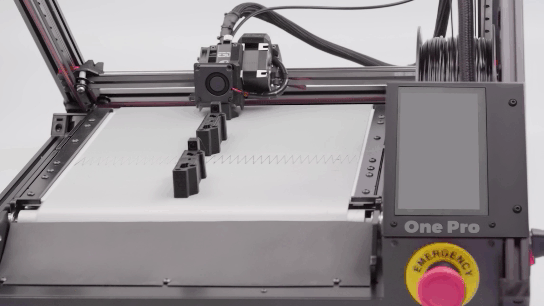Recently, our founding team, Artur Steffen & Martin Huber, visited a local university to inform the students about the potential of 3D belt printing for serial production. Close collaboration with students runs through the young tech company’s corporate history so far: several final theses have already been written around the multifaceted topic of belt printing, all with the purpose of drawing new incentives for innovation from the elaborations.
FOM University of Applied Sciences: Guest lecture on 3D belt printing
During a guest lecture in front of a large number of dual students, followed by practical work, they looked at the special features of this form of 3D printing. The students from the IT Trends & Innovation course were eager to learn about the latest technology and how it can be used in practice. Our team members shared their expertise and practical experience with 3D printing in the guest lecture and demonstrated the process step by step. Students were amazed at the accuracy and speed of printing and were impressed by the variety of materials that can be used.
Collaborations with universities help highlight benefits of 3D belt technology
Among other things, we talked about the benefits of 3D belt printing in batch production, such as reduced production time and cost, greater design flexibility, and the ability to produce complex geometries. This topic was considered and evaluated by a working student over several months in the final thesis “Economic viability and applicability of 3D belt printers in serial production in manufacturing companies”. The results of the work showed that 3D printing with belt technology almost always pays off for quantities of up to 50,000 parts. Particularly in comparison to Cartesian printers, belt printing already proves advantageous after a few hundred pieces at the latest. On the one hand, this is particularly due to the reduction in staff working time, as the printers produce the same or even higher output with much less human interaction. On the other hand, complex structures can be produced on the 3D belt printer with a significantly reduced need for support structures. This advantage results from the print head being angled at 45°. This saves material, and also labor, since the structures do not have to be manually removed from the printed piece. The students were enthusiastic about these features and asked many insightful questions.
R&D department benefits from qualified feedback
Overall, the guest lecture was a great success and our team was happy to share their knowledge with the next generation of engineers and designers. We hope the students gained a better understanding of 3D printing and its potential for the future of manufacturing. But iFactory3D also benefits directly from the interaction with the students. Especially in the practical part, where a communication strategy was to be thought up in groups for a new product development, many suggestions were given that iFactory3D will follow up on afterwards. Feedback for ideas from the research and development department is especially valuable when covering as many angles as possible.
Guest lecture in the course of the long partnership between iFactory3D and the Kulister Network
The cooperation between iFactory3D and FOM was initiated by guest lecturer Siju Samuelkutty. The leadership coach for digital transformation and the Düsseldorf-based startup have already worked together successfully in the past. The Kulister network, founded and managed by Samuelkutty, is designed precisely for this kind of exchange and enrichment of education and companies. There, startups meet established companies, universities and representatives of politics as well as administration in order to position good ideas on the market and develop future-oriented solutions.
 Serial production
Serial production
